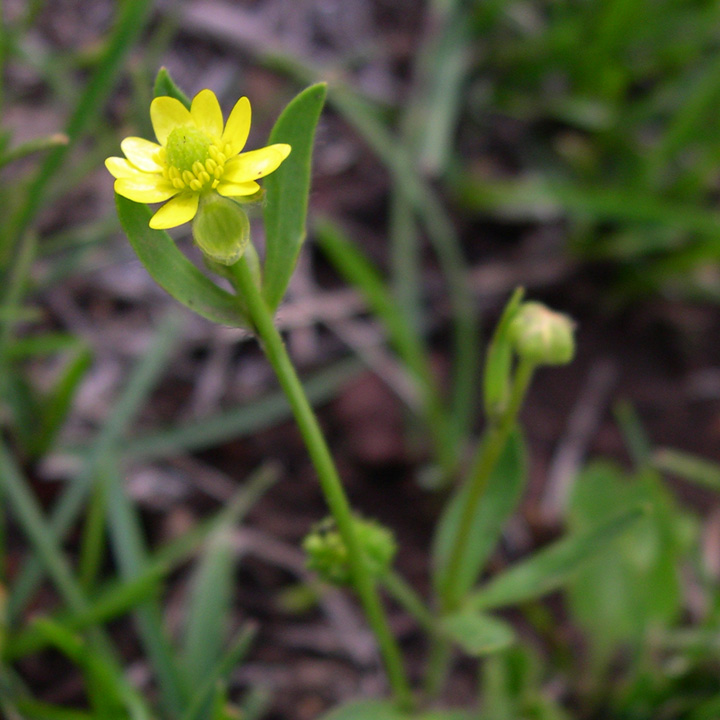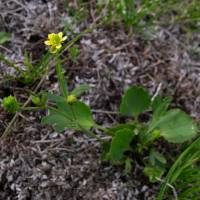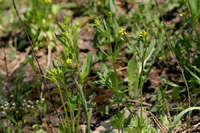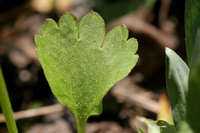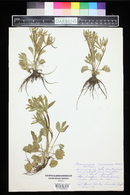|
|
|
|
Family: Ranunculaceae
graceful buttercup
[Ranunculus affinis var. micropetalus Greene] |
Stems erect, 5-33 cm, pilose or glabrous, each with 3-7 flowers. Roots slender, 0.6-1.2 mm thick. Basal leaves persistent, blades ovate, obovate or orbiculate, rarely reniform, undivided or innermost with 2 clefts or partings near apex, 1-3.7 × 1.1-3.5 cm, base acute to rounded, margins entire, apex rounded. Flowers: pedicels appressed-pubescent; receptacle pilose or glabrous; sepals 3-5 × 2-3 mm, abaxially pilose, hairs colorless; petals 5, 4-9 × 2-5 mm; nectary scale glabrous. Heads of achenes cylindric, 7-17 × 5-8 mm; achenes 1.5-2 × 1.3-1.8 mm, canescent or glabrous; beak subulate, straight or hooked, 0.4-2 mm. The Navaho-Ramah considered Ranunculus inamoenus to be an effective hunting medicine, used to protect hunters from their prey (D. E. Moerman 1986).
Duration: Perennial Nativity: Native Lifeform: Forb/Herb General: Perennial, 5-33 cm tall; stems erect, pilose or glabrous; roots slender. Leaves: Basal and cauline, alternate, basal blades ovate, obovate, or orbicular, undivided or 2-cleft or 2-parted near the apex, 1-3.7 cm long, 1-3.5 cm wide, cauline blades usually deeply cleft or parted, glabrous to sparsely pilose, margins crenate, base acute to rounded, apex rounded; basal blades petiolate, cauline blades sessile or nearly so. Flowers: Inflorescence a cyme, 1-4 flowered; pedicels glabrous or nearly so; sepals 5, 5-8 mm long, glabrous or sparsely pilose externally; petals 5-10, 8-13 mm long, yellow; nectary scale glabrous or ciliate; flowers March-July. Fruits: Achene, numerous, arranged in a cylindric head, 7-17 mm long, 5-8 mm wide; body of achene 1.5-2 mm long, pubescent to glabrous, the beak straight or hooked, 0.4-2 mm long. Ecology: Meadows, rocky slopes, open woods, coniferous forests, subalpine habitats; 2000-3700 m (6500-12000 ft); Apache, Coconino, and Gila counties; western Canada, western to southwestern U.S. Notes: Two varieties occur within our range and are differentiated as follows: var inamoenus is more widespread, has sepals 3-5 mm long, and beaks of the achenes are 0.4-0.9 mm long; var. subaffinis is endemic to the San Francisco Peaks, has sepals 5-7 mm long, and beaks of achenes are 1.4-2 mm long. Ranunculus cardiophyllus (heartleaf buttercup) is distinguished by being somewhat taller (11-53 cm tall) and more robust; basal leaves are ovate or elliptic, undivided or 3-5 parted, 2.2-6.9 cm long 1.8-4.5 cm wide, margins are crenate; petals are mostly 5-10 (occasionally absent), 6- 13 mm long, yellow; nectary scale is ciliate, or sometimes glabrous; beak of achene is curved or straight. It commonly occurs in meadows and along lakeshores, often in moist soils. The Navajo prepare a lotion from cold tea of R. inamoenus to protect hunters from animals. Editor: Springer et al. 2008 |


